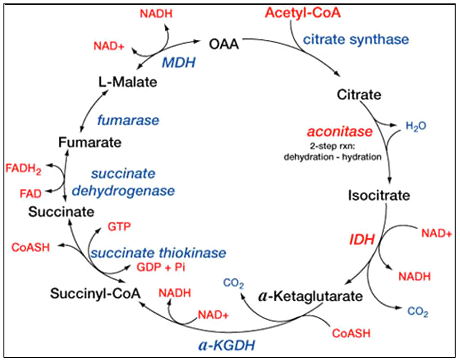
Concept explainers
(a)
Interpretation:
The name of four compounds with four carbon dicarboxylic acids in citric acid cycle should be given.
Concept Introduction:
Citric Acid Cycle: It involves 8 series reaction which converts acetyl group present in acetyl coenzyme A into 2

Figure 1
(b)
Interpretation:
The four compound with four dicarboxylic acid groups present in citric acid cycle should be arranged from least to most oxidized.
Concept Introduction:
Carboxylic acid: One
Citric Acid Cycle: It involves 8 series reaction which converts acetyl group present in acetyl coenzyme A into 2
Oxidation: The oxidation is reaction that involves addition of oxygen atom or loss of electrons or removal of hydrogen atom present in the chemical compound.
Reduction: It involves removal of oxygen or addition of hydrogen to the chemical compound.
Want to see the full answer?
Check out a sample textbook solution
Chapter 21 Solutions
FUND.OF GEN CHEM CHAP 1-13 W/ACCESS
- What are some topics of interest that neurotoxicologists study? For example, toxin-induced seizures, brain death, and such along those lines?arrow_forwardCould you help me with the explanation of the answer to exercise 15, chapter 1 of Lehinger Question Nombramiento de estereoisómeros con dos carbonos quirales utilizando el sistema RS(R,R)El isómero del metilfenidato (Ritalin) se utiliza para tratar el trastorno por déficit de atención con hiperactividad (TDAH).(S,S)El isómero es un antidepresivo. Identifique los dos carbonos quirales en la siguiente estructura. ¿Es este el(R,R)o el(S,S)¿isómero? Dibuja el otro isómero. Nombramiento de estereoisómeros con dos carbonos quirales utilizando el sistema RS(R,R)El isómero del metilfenidato (Ritalin) se utiliza para tratar el trastorno por déficit de atención con hiperactividad (TDAH).(S,S)El isómero es un antidepresivo.arrow_forwardThe reaction A+B → C + D AG°' = -7.3 kcal/mol can be coupled with which of the following unfavorable reactions to drive it forward? A. EFG+HAG° = 5.6 kcal/mol. B. J+KZ+A AG° = 2.3 kcal/mol. C. P+RY+DAG° = 8.2 kcal/mol. D. C + T → V + W AG°' = -5.9 kcal/mol. E. AN→ Q+KAG°' = 4.3 kcal/mol.arrow_forward
- What would be the toxicological endpoints for neurotoxicity?arrow_forwardWhat are "endpoints" in toxicology exactly? Please give an intuitive easy explanationarrow_forwardFura-2 Fluorescence (Arbitrary Unit) 4500 4000 3500 3000 2500 2000 1500 1000 500 [Ca2+]=2970nM, 25°C [Ca2+] 2970nM, 4°C [Ca2+]=0.9nM, 25°C [Ca2+] = 0.9nM, 4°C 0 260 280 300 340 360 380 400 420 440 Wavelength (nm) ← < The figure on the LHS shows the excitation spectra of Fura-2 (Em = 510 nm) in 2 solutions with two different Ca2+ ion concentration as indicated. Except for temperature, the setting for excitation & signal acquisition was identical.< ப a) The unit in Y-axis is arbitrary (unspecified). Why? < < b) Compare & contrast the excitation wavelength of the Isosbestic Point of Fura-2 at 25 °C & 4 °C. Give a possible reason for the discrepancy. < c) The fluorescence intensity at 25 °C & 4 °C are different. Explain why with the concept of electronic configuration. <arrow_forward
- draw in the structure of each amino acid (as L-amino acids) using the Fischer projection style. an example has been included. Draw the structure for glycine, alanine, valine, isoleucine, methionine, proline, phenylalanine, tryptophan, serine, threonine, asparagine, glutamine, lysine, arginine, aspartic acid, glutamic acid, histidine, tyrosine, cysteinearrow_forwarddraw in the structure of each amino acid (as L-amino acids) using the Fischer projection style. an example has been includedarrow_forwarddraw in the structure of each amino acid (as L-amino acids) using the Fischer projection style. an example has been includedarrow_forward
- Draw out the following peptide H-R-K-E-D at physiological pH (~7.4). Make sure toreference table 3.1 for pKa values.arrow_forwardThe table provides the standard reduction potential, E', for relevant half-cell reactions. Half-reaction E'° (V) Oxaloacetate² + 2H+ + 2e malate²- -0.166 Pyruvate + 2H+ + 2e → lactate -0.185 Acetaldehyde + 2H+ + 2e¯ →→→ ethanol -0.197 NAD+ + H+ + 2e--> NADH -0.320 NADP+ + H+ + 2e →→ NADPH Acetoacetate + 2H+ + 2e¯ - -0.324 B-hydroxybutyrate -0.346 Which of the reactions listed would proceed in the direction shown, under standard conditions, in the presence of the appropriate enzymes? Malate + NAD+ oxaloacetate + NADH + H+ Malate + pyruvate oxaloacetate + lactate Pyruvate + NADH + H+ lactate + NAD+ Pyruvate + p-hydroxybutyrate lactate + acetoacetate Acetaldehyde + succinate ethanol + fumerate Acetoacetate + NADH + H+ → B-hydroxybutyrate + NAD+arrow_forwardArrange the four structures in order from most reduced to most oxidized. Most reduced R-CH2-CH3 R-CH2-CH₂-OH R-CH,-CHO R-CH₂-COO Most oxidizedarrow_forward
 Human Heredity: Principles and Issues (MindTap Co...BiologyISBN:9781305251052Author:Michael CummingsPublisher:Cengage Learning
Human Heredity: Principles and Issues (MindTap Co...BiologyISBN:9781305251052Author:Michael CummingsPublisher:Cengage Learning BiochemistryBiochemistryISBN:9781305577206Author:Reginald H. Garrett, Charles M. GrishamPublisher:Cengage Learning
BiochemistryBiochemistryISBN:9781305577206Author:Reginald H. Garrett, Charles M. GrishamPublisher:Cengage Learning Anatomy & PhysiologyBiologyISBN:9781938168130Author:Kelly A. Young, James A. Wise, Peter DeSaix, Dean H. Kruse, Brandon Poe, Eddie Johnson, Jody E. Johnson, Oksana Korol, J. Gordon Betts, Mark WomblePublisher:OpenStax College
Anatomy & PhysiologyBiologyISBN:9781938168130Author:Kelly A. Young, James A. Wise, Peter DeSaix, Dean H. Kruse, Brandon Poe, Eddie Johnson, Jody E. Johnson, Oksana Korol, J. Gordon Betts, Mark WomblePublisher:OpenStax College Concepts of BiologyBiologyISBN:9781938168116Author:Samantha Fowler, Rebecca Roush, James WisePublisher:OpenStax College
Concepts of BiologyBiologyISBN:9781938168116Author:Samantha Fowler, Rebecca Roush, James WisePublisher:OpenStax College Biology 2eBiologyISBN:9781947172517Author:Matthew Douglas, Jung Choi, Mary Ann ClarkPublisher:OpenStax
Biology 2eBiologyISBN:9781947172517Author:Matthew Douglas, Jung Choi, Mary Ann ClarkPublisher:OpenStax





